 W
WThe ionosphere is the ionized part of Earth's upper atmosphere, from about 48 km (30 mi) to 965 km (600 mi) altitude, a region that includes the thermosphere and parts of the mesosphere and exosphere. The ionosphere is ionized by solar radiation. It plays an important role in atmospheric electricity and forms the inner edge of the magnetosphere. It has practical importance because, among other functions, it influences radio propagation to distant places on the Earth.
 W
WA Birkeland current is a set of currents that flow along geomagnetic field lines connecting the Earth's magnetosphere to the Earth's high latitude ionosphere. In the Earth's magnetosphere, the currents are driven by the solar wind and interplanetary magnetic field and by bulk motions of plasma through the magnetosphere. The strength of the Birkeland currents changes with activity in the magnetosphere. Small scale variations in the upward current sheets accelerate magnetospheric electrons which, when they reach the upper atmosphere, create the Auroras Borealis and Australis. In the high latitude ionosphere, the Birkeland currents close through the region of the auroral electrojet, which flows perpendicular to the local magnetic field in the ionosphere. The Birkeland currents occur in two pairs of field-aligned current sheets. One pair extends from noon through the dusk sector to the midnight sector. The other pair extends from noon through the dawn sector to the midnight sector. The sheet on the high latitude side of the auroral zone is referred to as the Region 1 current sheet and the sheet on the low latitude side is referred to as the Region 2 current sheet.
 W
WThe ionosphere is the ionized part of Earth's upper atmosphere, from about 48 km (30 mi) to 965 km (600 mi) altitude, a region that includes the thermosphere and parts of the mesosphere and exosphere. The ionosphere is ionized by solar radiation. It plays an important role in atmospheric electricity and forms the inner edge of the magnetosphere. It has practical importance because, among other functions, it influences radio propagation to distant places on the Earth.
 W
WThe equatorial electrojet (EEJ) is a narrow ribbon of current flowing eastward in the day time equatorial region of the Earth's ionosphere. The abnormally large amplitude of variations in the horizontal components measured at equatorial geomagnetic observatories, as a result of EEJ, was noticed as early as 1920 from Huancayo geomagnetic observatory. Observations by radar, rockets, satellites, and geomagnetic observatories are used to study EEJ.
 W
WA geomagnetic storm, also known as a magnetic storm, is a temporary disturbance of the Earth's magnetosphere caused by a solar wind shock wave and/or cloud of magnetic field that interacts with the Earth's magnetic field.
 W
WThe High-frequency Active Auroral Research Program (HAARP) was initiated as an ionospheric research program jointly funded by the U.S. Air Force, the U.S. Navy, the University of Alaska Fairbanks, and the Defense Advanced Research Projects Agency (DARPA). It was designed and built by BAE Advanced Technologies. Its original purpose was to analyze the ionosphere and investigate the potential for developing ionospheric enhancement technology for radio communications and surveillance. As a university-owned facility, HAARP is a high-power, high-frequency transmitter used for study of the ionosphere.
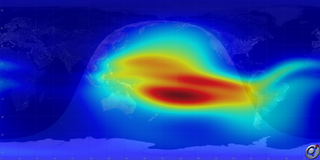 W
WInternational Reference Ionosphere (IRI) is a common permanent scientific project of the Committee on Space Research (COSPAR) and the International Union of Radio Science (URSI) started 1968/69. It is the international standard empirical model for the terrestrial ionosphere since 1999. For a specified geographic location, time, and date, IRI provides average monthly values for electron density, electron temperature and ion temperature, and the molecular composition of the ions in the range of altitudes from 50 km to 2000 km. The latest standard is IRI-2012. A new version, IRI-2016, has since been released. The IRI has been extended to plasmasphere in the IRI-Plas model.
 W
WIonized-air glow is the fluorescent emission of characteristic blue–purple–violet light, often of a color called electric blue, by air subjected to an energy flux either directly or indirectly from solar radiation.
 W
WAn ionosonde, or chirpsounder, is a special radar for the examination of the ionosphere. The basic ionosonde technology was invented in 1925 by Gregory Breit and Merle A. Tuve and further developed in the late 1920s by a number of prominent physicists, including Edward Victor Appleton. The term ionosphere and hence, the etymology of its derivatives, was proposed by Robert Watson-Watt.
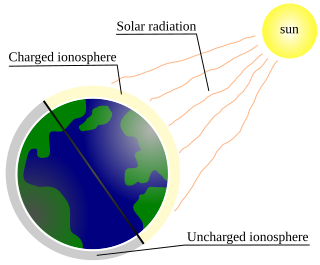 W
WIonospheric absorption is the scientific name for absorption occurring as a result of the interaction between various types of electromagnetic waves and the free electrons in the ionosphere, which can interfere with radio transmissions.
 W
WMost global navigation satellite systems (GNSS) are subjected to errors induced by the ionosphere. Because ionospheric delay affects the speed of microwave signals differently depending on their frequency—a characteristic known as dispersion, delays measured on two or more frequency bands can be used to measure dispersion, and this measurement can then be used to estimate the delay at each frequency.
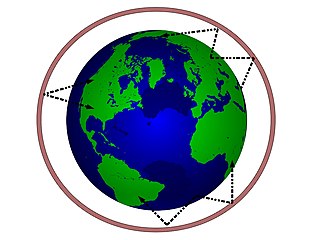 W
WIn radio communication, skywave or skip refers to the propagation of radio waves reflected or refracted back toward Earth from the ionosphere, an electrically charged layer of the upper atmosphere. Since it is not limited by the curvature of the Earth, skywave propagation can be used to communicate beyond the horizon, at intercontinental distances. It is mostly used in the shortwave frequency bands.
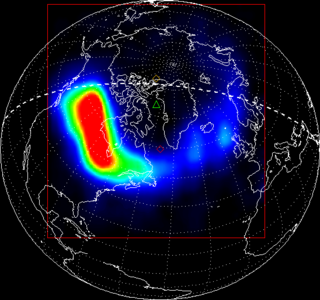 W
WIonospheric storms are storms which contain varying densities of energised electrons produced from the sun. They are categorised into positive and negative storms, where positive storms have a high density of electrons and negative storms contain a lower density. This is measured in total electron content (TEC), and is a key variable used in data to record and compare the intensities of ionospheric storms. Ionospheric storms are caused by geomagnetic storms.
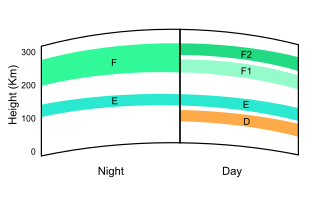 W
WThe Heaviside layer, sometimes called the Kennelly–Heaviside layer, named after Arthur E. Kennelly and Oliver Heaviside, is a layer of ionised gas occurring roughly between 90km and 150 km above the ground — one of several layers in the Earth's ionosphere. It is also known as the E region. It reflects medium-frequency radio waves. Because of this reflective layer, radio waves radiated into the sky can return to Earth beyond the horizon. This "skywave" or "skip" propagation technique has been used since the 1920s for radio communication at long distances, up to transcontinental distances.
 W
WIn astronomy and planetary science, a magnetosphere is a region of space surrounding an astronomical object in which charged particles are affected by that object's magnetic field. It is created by a celestial body with an active interior dynamo.
 W
WThe Schumann resonances (SR) are a set of spectrum peaks in the extremely low frequency (ELF) portion of the Earth's electromagnetic field spectrum. Schumann resonances are global electromagnetic resonances, generated and excited by lightning discharges in the cavity formed by the Earth's surface and the ionosphere.
 W
WIn radio communication, skywave or skip refers to the propagation of radio waves reflected or refracted back toward Earth from the ionosphere, an electrically charged layer of the upper atmosphere. Since it is not limited by the curvature of the Earth, skywave propagation can be used to communicate beyond the horizon, at intercontinental distances. It is mostly used in the shortwave frequency bands.
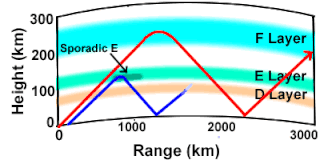 W
WSporadic E is an unusual form of radio propagation using characteristics of the Earth's ionosphere. Whereas most forms of skywave propagation use the normal and cyclic ionization properties of the ionosphere's F region to refract radio signals back toward the Earth's surface, sporadic E propagation bounces signals off smaller "clouds" of unusually ionized atmospheric gas in the lower E region. This occasionally allows for long-distance communication at VHF frequencies not usually well-suited to such communication.
 W
WThe TIMED mission is dedicated to study the influences energetics and dynamics of the Sun and humans on the least explored and understood region of Earth's atmosphere – the Mesosphere and Lower Thermosphere / Ionosphere (MLTI). The mission was launched from Vandenberg Air Force Base in California on 7 December 2001 aboard a Delta II rocket launch vehicle. The project is sponsored and managed by NASA, while the spacecraft was designed and assembled by the Applied Physics Laboratory at Johns Hopkins University. The mission has been extended several times, and has now collected data over an entire solar cycle, which helps in its goal to differentiate the Sun's effects on the atmosphere from other effects.
 W
WTotal electron content (TEC) is an important descriptive quantity for the ionosphere of the Earth. TEC is the total number of electrons integrated between two points, along a tube of one meter squared cross section, i.e., the electron columnar number density. It is often reported in multiples of the so-called TEC unit, defined as TECU=1016el/m2≈1.66×10−8 mol⋅m−2.
 W
WA whistler is a very low frequency or VLF electromagnetic (radio) wave generated by lightning. Frequencies of terrestrial whistlers are 1 kHz to 30 kHz, with a maximum amplitude usually at 3 kHz to 5 kHz. Although they are electromagnetic waves, they occur at audio frequencies, and can be converted to audio using a suitable receiver. They are produced by lightning strikes where the impulse travels along the Earth's magnetic field lines from one hemisphere to the other. They undergo dispersion of several kHz due to the slower velocity of the lower frequencies through the plasma environments of the ionosphere and magnetosphere. Thus they are perceived as a descending tone which can last for a few seconds. The study of whistlers categorizes them into Pure Note, Diffuse, 2-Hop, and Echo Train types.